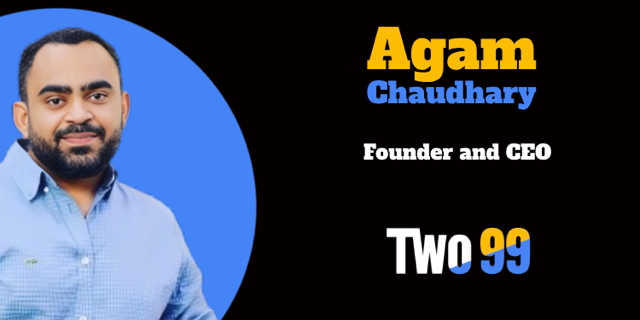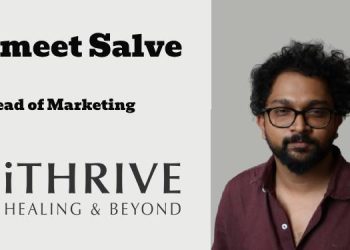Two99 is a collective of agencies with a focus on advanced e-commerce, technology, and marketing. Two99 says that its focus rests on helping businesses grow their topline and buttomlines. It said that its faith in achieving excellence, fostering innovation, and holistically driven solutions helps it deliver results that go above and beyond its clients requirements. It exists to empower businesses, be it big and small, to achieve sustainable success in an ever-evolving digital landscape.
Two99 adopts a holisitic approach. Experts take a holistic approach to customise solutions specifically for a client. The aim is to give clients a boost in their confidence to take informed decisions and implement customised strategies that align with their goals.
Medianews4u.com caught up with Agam Chaudhary, Founder and CEO – Two99
Q. Two99 reported a first-quarter growth rate of 30 per cent. What factors are driving growth?
If you look at the macro picture, I’d say that it is our consultative approach to solving our partners’ business challenges that has helped us gain additional and larger mandates.
A consultative approach does away with the one-size-fits-all method, and instead provides solutions to problems that are specific to each client, resulting in increased efficiencies on both time and monetary scales.
Zooming in, we have a framework built on four primary dials: Elevating User Experience, Creating Contributing Communities, Deploying Efficient Distribution, and Using Custom Analytics.
Most of the challenges faced by our partners lie on a landscape within these four pillars and we can turn the dials up or down on each to arrive at optimal solutions.
In case of outlier challenges, the consultative approach helps us yet again, as we then get into a huddle with the client and tailor solutions that are extremely specific and likely innovative.
This Four plus One approach has helped us grow not only in terms of revenue, but also in terms of solutioning capabilities.
Q. For the rest of 2024, what are the targets and the game plan to get there?
The primary target is to maintain our growth trajectory in a sustainable manner. The fickle nature of topline growth has been an obvious ailment in the past half a decade, and we’d want to avoid the pitfalls by means of consolidation of operational aspects.
Which is not to say that we will turn our backs to expansion. Far from it, we intend to expand our portfolio of clients, partners and workforce pretty aggressively. However, it will be measured and pragmatic.
Horizontal expansion aside, we are aiming to increase our ARPC (average revenue per client), by between 20-30%. Which means a lot of focus on depth and winning additional mandates from existing clients through excellence in delivery.
We’ve been putting a lot of focus on capability fortification and expansion in terms of human resource, tech stacks, skill upgradation and keeping up with the neck-snapping pace of evolution in AI tech. That focus will continue for the rest of this year (and possibly into the next couple of years as well).

Q. Could you talk about the company’s data-driven approach that helps boost clients’ revenues?
A lot is said about the science of data collection and analysis for business needs. And to be honest, we’ve been convinced of the power that data provides through our entirety. We’ve been using it to influence our decisions through the entire value chain, from strategy to deployment.
However, as the quality and quantity of data has increased, we’ve been focussing more and more on the art of data interpretation over just the scientific approach to it.
For example, we recently worked with a client who thought their target audience was primarily in their 40s basis affinity categories and ticket size. They were basing their marketing strategy and budget on that assumption.
But when we dug into the data, we saw a completely different picture. Their most engaged audience was actually in their 20s to 30s.Turned out that the consumption patterns in the category had lent to premiumisation.
By shifting their focus to this demographic, we were able to optimise their media campaigns and significantly improve their return on investment. It’s all about using data to make smarter decisions and drive better results.
Q. Could you provide examples of work done recently that stands out?
Sure. We recently partnered with two prominent apparel brands, JadeBlue and Bonjour. Additionally, we’ve been working in the infrastructure sector with Wonder Cements.
For JadeBlue, we helped them achieve a 15% month-over-month growth in direct-to-consumer sales, and their marketplace sales grew by 25%. We also saw incredible improvements in their return on ad spend across different channels.
For Bonjour, we significantly improved their return on investment on both direct-to-consumer and marketplace sales, and their customer repeat rate jumped from 15% to 41%. These are just a couple of examples, but they highlight the impact our comprehensive approach can have on our clients’ businesses.
We have been able to assist Wonder Cements not only in their core business KPIs, but also on CSR initiatives within their ambit. The company has tied up with IPL and we will be assisting them to expand further in their endeavour to promote local cricket talent, as well as communicating association with topline brands events in the sport.
Q. One area of focus is to strengthen branding and e-commerce. How is this being done?
Branding involves creating personas that align as closely to the business as possible, and then disseminating meaningful messaging in the tone-of-voice that belongs to said persona.
We adopt multiple frameworks to help brands create and refine their being through psychological frameworks. The resulting output has a much higher resonance with the target audience versus the output that emerges purely from aspirations of business leaders.
We refer to frameworks such as Jungian archetypes to humanise brands. A humanised brand results in authentic communication, relatability, empathy and hence engagement. It also goes a long way in reducing spillage and offering superior marketing ROI / ROAS.
Far as disseminating media through platforms is concerned, we have been watching with concern as the market share of search advertising giants diminishes. Therefore’ve had to democratise ad spend across channels in line with change in consumer behaviour(s).
Similarly for e-commerce, we have realised the renewed importance of owning shopfronts. While a majority of revenue still flows through aggregators, business-owned shopfronts have seen resurgence with success stories being written by some D2C brands.
Here is where community building also comes into play, as the authenticity of product information and related reviews on aggregators increasingly carries a burden of doubt.
A community that is evangelical goes a long way in trust creation and lowering spending in combating astroturfing campaigns. Hence we have been hammering in this aspect with all the brands we work with.
Q. What role is AI playing in helping Two99 offer better solutions?
This question is best answered as an extension to the previous one pose dregarding e-commerce. Traditionally, analysing massive amounts of data, especially so, in sectors like e-commerce was a time-consuming task.
AI has changed that for good. Now, we can process massive datasets quickly and from multiple perspectives to find out the hidden insights that inform our marketing strategies.
AI also lets us predict consumer behaviour, personalise messaging at scale, and automate repetitive tasks. This frees up our team’s time to focus on creative and strategic initiatives.
For instance, our AI-powered tools helped a client identify high-potential customer segments prone to specific conversion strategies. By targeting these segments with strategic offers, the client achieved a ~32% increase in conversion rates.
For a company to do better when it comes to KPIs like customer acquisition cost and lifetime value, what do they need to keep in mind?
The lowest-hanging fruits to keep both those metrics healthy are authenticity and customer-centricity. Yet, we see a plethora of businesses ignore those business principles in favour of chasing short term goals.
You have to communicate clearly what you are not selling, in addition to the obvious messaging of what you are. The short term strategy of overpromising and window dressing your products / brand is a recipe for disaster as word-of-mouth carries like a summer fire in our digital landscape. So not only do you lose out on CLV, your CAC also rises astronomically.
Clear communication also puts your CAC optimisation on steroids as it helps choose the right channels, audience and ensures minimal spillage.
A brand also needs to develop a sturdy support ecosystem for existing customers so that the consumption of the product / service does not get mired in frustration and abandonment and instead is a source of delight. A great way to do that again is community building, which is a long term process, but ultimately serves a brand much better than a purely inorganic, high-churn support endeavour does. Yes, you have to start with the latter, but it is highly advisable to steadily switch to the former.
Here, I have a personal example. As an owner of an iphone, I have been an Apple music consumer. However, seeing multiple ads of Spotify and having had multiple Spotify links sent to me, I shifted to the platform on a whim.
As it turned out the streaming quality on Apple Music is far better than on Spotify Premium and the price difference between both is minimal. So, I was back on Apple music within, but not before they’d offered me an additional three months free streaming.
Had Apple communicated clearly about their superiority of service over other platforms, I would not have left, and then come back, costing them three months of revenue as CAC / CRC.
Also, had Spotify been fair with their pricing (authenticity), I would not have completely disregarded their upcoming (rumoured) platinum tier with higher bitrates, as my association with the brand wouldn’t be tainted by blotched sound quality of Bohemian Rhapsody on a Sunday morning.

Q. Two99 also helps brands focus on the importance of collaboration and a positive culture. Are these aspects often ignored because there is too much focus on short-term goals?
A simple analogy here. An organisation is like a person, and a person is a sum of all his parts. Various organs collaborate to keep us functional, and if you add a layer of optimism to a well functioning individual, it more often than not turns into a success story.
That’s how we work at Two99. Each constituent, each department has a certain role, and specific needs. We’ve taken great care to put that in place and hence have experienced very little friction in operations.
The lesson is thus suggested to the brands we work with. We preach (and help attain) balance plus collaboration amongst the many constituent parts, and then within the micro constituents within those parts.
This approach not only helps efficiency, but also helps us quickly derive issues if the system goes off-kilter.
A short term approach might give you an inorganic being that functions, but it will be more a Frankenstein’s Monster (best case scenario) than a functional human being.
Q. Are clients nervous about entering a cookieless world?
Changes are unsettling for sure. If you’re asked to suddenly change your daily functioning to your non-dominant hand, no questions it’ll throw you off for a bit.
However, that will not stop you from living as you will slowly learn to be dexterous with the other hand, and life will shortly continue as normal.
It’s pretty much the same in this instance. We’ve been racing along this track for a while and now is the time to learn how to do it on an alternate route.
We have been exploring alternative strategies, such as using first-party data, contextual advertising, and using AI to understand consumer behaviour to reduce our dependence on now-traditional routes.
By staying agile to industry changes and positively adapting our approaches, we are helping our clients navigate this shift confidently and continue achieving their marketing goals. Using either hand.

Q. What work has Two99 done when it comes to helping clients with digital transformation?
We’ve be working with a standard suite of interventions aimed at DigitalTransformation such as digital strategy development (assessment and audits, roadmap creation), website and e-commerce development (website redesign and optimisation, e-commerce solutions), digital marketing and advertising (SEO, content marketing, SMM, paid advertising), customer experience enhancement (UX design, customer relationship management), data analytics and insights (data collection and management, analytics and reporting). Plus we have been implementing solutions specific to technology integration and automation such as marketing automation platforms, chatbots, and workflow automation software.
The number of layers required in the stack varies between customers and solutioning is arrived at after extensive research (including use of data sussed with the assistance of AI tools).
Q. Besides India, Two99 operates in other markets like the US, Middle East, Southeast Asia. What are the similarities and differences between the markets?
The overarching theme that applies regardless of geographic location is relevancy.Whether it be between product/service and the target audience or target audience and media platforms. IPAs will not sell well with boomers on right leaning podcasts. However, sell a dog accessories pride collection to millennials in coastal cities through a pet influencer on Instagram, and you might as well have hit the jackpot. Marketing is getting extremely niche-focused and it is critical that you know your target audience, no matter where you are.
In terms of differences, there are innumerable, but here are some top-of-mind points.
In the United States, digital marketing is characterised by a mature and highly competitive market where advanced technologies and data-driven strategies are essential. Google dominates the search engine landscape, making SEO and PPC critical components of digital strategies. Content marketing, video marketing, and influencer partnerships have become critical to crack given the affinity of younger cohorts towards reels, tik-toks and live streaming.. Additionally, marketers must navigate strict regulatory environments, including adherence to data privacy laws like GDPR and CCPA, and follow clear advertising standards.
In contrast, the GCC bloc is a group of wealthy nations like the UAE, Saudi Arabia, and Qatar, comprising a consumer base with high disposable incomes, leading to a preference for luxury brands and services. Mobile-first strategies are crucial due to high smartphone usage. Social media platforms such as Instagram, Snapchat, and Twitter are popular, with localised content and Arabic language marketing gaining traction. The regulatory environment in the GCC is evolving, with increasing emphasis on data protection and privacy.
Southeast Asia presents a diverse and fast-growing digital market, with significant variations between countries. Mobile internet usage is predominant, driven by affordable smartphones and data plans. Social media platforms like Facebook, Instagram, and LINE are widely used, and e-commerce is booming with platforms such as Lazada and Shopee leading the market. Influencer marketing and live streaming are highly effective in engaging consumers.
Each country within SEA has its own regulatory landscape, with varying levels of maturity regarding data privacy and consumer protection laws. Understanding local languages, cultures, and consumer behaviours is crucial for effective digital marketing in this region.

















